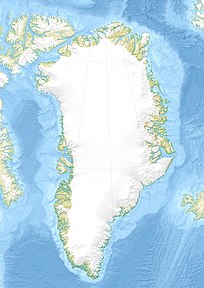Attu (Greenland)
| Attu | ||
|---|---|---|
| Agto | ||
| Attu (2017) | ||
| Commune | Qeqertalik municipality | |
| District | Kangaatsiaq | |
| Geographical location | 67 ° 56 '25 " N , 53 ° 37' 19" W | |
|
|
||
| Residents | 203 (January 1, 2020) |
|
| founding | 1818 | |
| Time zone | UTC-3 | |
Attu [ ˈatːu ] (according to the old spelling Agto ) is a Greenlandic settlement in the municipality of Qeqertalik in the district of Kangaatsiaq .
location
Attu is the southernmost inhabited village of the municipality and is located on the island of the same name . Aqisserniaq , separated by the Attup Imaa fjord , eight kilometers further south, has now been abandoned. The nearest settlement is Ikerasaarsuk , located to the north-northeast, 23 km away.
history
Attu is north of the area around the colony Gamle Egedesminde , which was heavily inhabited in the 18th century , but Attu itself was probably uninhabited at that time.
Attu was founded in 1818 with the status of a facility and replaced a previous attempt to catch yarn on the western island of Uummannaq (Rifkol). In 1821 Attu had 20 residents, while Akunnaaq south of Rifkol had 44 residents. In 1829 there was a disguised Greenlandic house for the assistant in Attu, a half-timbered house with wood paneling as a store and shop, a shed and a bacon house as a peat wall house. At that time Attu, Ikerasak , Upernaviarsuk and Nasersorfik had a total of 119 inhabitants. In 1831 Ikerasak and Upernaviarsuk were uninhabited and Nasersorfik and Attu together had 68 inhabitants.

In 1850 Attu was named Udsted . That year Attu, Aqisserniaq , Ikerasak and Saattut had a total of 165 inhabitants. In 1915 the place had 72 inhabitants, three of whom were Danish. There were eleven residential buildings and several public buildings in Attu. The Udsteds administrator's apartment was a one-storey building from 1864 with three rooms and a kitchen. The shop was built in 1908 as a half-timbered building with wood paneling. There was a bacon house from 1859, a cooperage and a packing house from 1905, which was a half-timbered building with a peat wall facade. The chapel dates from 1868 and was a half-timbered building with a peat wall facade and roof shingles, which was probably also used as a school. In addition to ten hunters, there was an Udsteds administrator, a midwife and a head catechist.
Between 1927 and 1932 a new school chapel, a shop with a warehouse, a salt factory and four small fish houses were built. In 1950 Attu had 50 inhabitants, in 1960 101 and by 1970 the population had risen to 337 people.
As Udsted, Attu was a separate community in the colonial district of Egedesminde . In 1918 the residential areas Ikerasak and Aqisserniaq still belonged to it. The municipality belonged to the 1st district electoral council of North Greenland. Attu belonged to the parish of Aasiaat and was the seat of the southernmost upper catechetical district of the parish. In 1950 Attu fell to the Kangaatsiaq community .
economy
There is a fish factory in Attu which mainly processes sea hare . Whale and bird hunting is also carried out. Other areas of work are, for example, in schools or in the service industry.
Infrastructure and supply
The port of Attu is on the north coast. Due to its location close to the high seas, it can be reached almost continuously from February to December. There is also a heliport for supplies in winter, for example. From there, Air Greenland organizes flights to Kangaatsiaq and Aasiaat , where Diskoline transports traffic in summer . There are only a few unpaved gravel roads.
The power supply is secured by a power station and the water is supplied by pipelines . Litter and sewage end up in the rubbish dump, but many also dump their sewage up the mountain. A waste incineration plant exists but does not work. The telecommunication is secured by TELE Greenland .
Development
There is a Pilersuisoq branch in town that supplies the residents with goods. In addition, there is a citizen's office, an infirmary, a service building, a church consecrated in 1974, a kindergarten with a capacity for twelve children and a school with fifty pupils, which is also used for other activities in the village, including a sports field and a village meeting point.
Sons and daughters
- Jakob Rasmussen (1871–1924), Provincial Councilor
- Gerth Geisler (1882–1934), trade administrator and regional councilor
Population development
In 1977 Attu was still the sixth largest village in Greenland. Since then, however, the population has fallen by almost half.

Web links
Individual evidence
- ↑ Map with all official place names confirmed by Oqaasileriffik , provided by Asiaq
- ^ A b c d Hother Ostermann : Beskrivelse af Distrikterne i Nordgrønland: Egedesminde district. De grandson Bopladser. Udstedet Agto . In: Georg Carl Amdrup , Louis Bobé , Adolf Severin Jensen , Hans Peder Steensby (eds.): Grønland i tohundredeaaret for Hans Egedes landing (= Meddelelser om Grønland . Volume 60-61 ). tape 1 . C. A. Reitzel Boghandel, Copenhagen 1921, p. 86 ff . ( Digitized in the Internet Archive ).
- ^ A b c Jens Christian Madsen: Udsteder og bopladser i Grønland 1901-2000 . Atuagkat, 2009, ISBN 978-87-90133-76-4 , pp. 130 f .
- ↑ a b c Attu at qaasuitsup-kp.cowi.webhouse.dk
- ↑ Population of Attu 1977–2020 at bank.stat.gl


